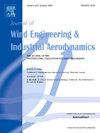自然通风干式冷却塔进气喷雾预冷与y型防风林良好组合的研究
IF 4.9
2区 工程技术
Q1 ENGINEERING, CIVIL
Journal of Wind Engineering and Industrial Aerodynamics
Pub Date : 2025-07-03
DOI:10.1016/j.jweia.2025.106159
引用次数: 0
摘要
侧风会影响自然通风干式冷却塔的气流,进而影响喷雾水滴的运动轨迹,影响干式冷却塔的预冷效果。本研究建立三维模型,模拟一台120 m高的NDDCT在7种喷雾预冷方案和y型防风林下的运行情况,优化其组合。仿真结果表明:(1)单圈布置喷嘴比不布置喷嘴可使塔的排热率提高7.01%(从123.68 MW提高到132.35 MW),而线性布置喷嘴可使塔的排热率提高5.84%(从123.68 MW提高到130.90 MW);(2)与不喷淋相比,三圆喷嘴布置的排热率最高,为147.99 MW,提高了22.89%;半径为21.50 m的单圆喷嘴布置的排热率最低,为129.10 MW,提高了7.21%;在41.50 m半径处,水蒸发比依次为一圈为100.00%,两圈为99.00%,三圈为98.52%;(3)半径为31.50 m和41.50 m、总水流量为14.8 kg/s、喷嘴数为74个的两圈布置喷嘴与y型防风林配合使用,可以很好地提高NDDCT井的散热性能(提高15.84%),即:从无喷雾时的120.42 MW增加到139.49 MW),用水量适中(不高也不低),为14.8 kg/s,水分蒸发率高达99.00%。本文章由计算机程序翻译,如有差异,请以英文原文为准。
Investigation on a good combination of inlet air spray pre-cooling and Y-type windbreak in a natural draft dry cooling tower
Crosswind affects the airflow of natural draft dry cooling towers (NDDCTs), which will in turn affect the trajectory of spray water droplets and will impair the pre-cooling effect of NDDCTs. This study develops 3-D models to simulate the operation of a 120 m high NDDCT with seven spray pre-cooling schemes and Y-type windbreak, aiming to optimize their combination. The simulation finds that: (1) The one-circle arranged spray nozzles increase the tower's heat rejection rate up to 7.01 % (increased from 123.68 MW to 132.35 MW) compared with no spray while the linear-arranged spray nozzles increase the heat rejection rate up to 5.84 % (increased from 123.68 MW to 130.90 MW); (2) The three-circle nozzle arrangement produces the highest heat rejection rate as 147.99 MW with an 22.89 % improvement compared with no spray, while the one-circle nozzle arrangement with the radius of 21.50 m produces the lowest heat rejection rate as 129.10 MW with an 7.21 % improvement; the water evaporation ratio follows the order of one-circle at the radius 41.50 m as 100.00 %, two-circle as 99.00 % and three-circle as 98.52 % is the last; (3) The two-circle arranged spray nozzles with the radii of 31.50 m and 41.50 m, the total water flowrate of 14.8 kg/s and nozzle number of 74 are found to be a good combination with the Y-type windbreak for performance improvement of the NDDCT, which improves the heat rejection performance of the NDDCT well (with 15.84 % improvement, i.e., increased from 120.42 MW at no spray to 139.49 MW) with moderate water consumption (not too high and not too low) of 14.8 kg/s and high water evaporation ratio of 99.00 %.
求助全文
通过发布文献求助,成功后即可免费获取论文全文。
去求助
来源期刊
CiteScore
8.90
自引率
22.90%
发文量
306
审稿时长
4.4 months
期刊介绍:
The objective of the journal is to provide a means for the publication and interchange of information, on an international basis, on all those aspects of wind engineering that are included in the activities of the International Association for Wind Engineering http://www.iawe.org/. These are: social and economic impact of wind effects; wind characteristics and structure, local wind environments, wind loads and structural response, diffusion, pollutant dispersion and matter transport, wind effects on building heat loss and ventilation, wind effects on transport systems, aerodynamic aspects of wind energy generation, and codification of wind effects.
Papers on these subjects describing full-scale measurements, wind-tunnel simulation studies, computational or theoretical methods are published, as well as papers dealing with the development of techniques and apparatus for wind engineering experiments.

 求助内容:
求助内容: 应助结果提醒方式:
应助结果提醒方式:


